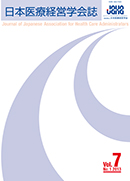Volume 7, Issue 1
Displaying 1-13 of 13 articles from this issue
- |<
- <
- 1
- >
- >|
Opening Article
-
2013Volume 7Issue 1 Pages 3
Published: August 31, 2013
Released on J-STAGE: September 13, 2013
Download PDF (135K)
Original Article
-
2013Volume 7Issue 1 Pages 5-13
Published: August 31, 2013
Released on J-STAGE: September 13, 2013
Download PDF (1190K) -
2013Volume 7Issue 1 Pages 15-22
Published: August 31, 2013
Released on J-STAGE: September 13, 2013
Download PDF (517K) -
2013Volume 7Issue 1 Pages 23-29
Published: August 31, 2013
Released on J-STAGE: September 13, 2013
Download PDF (882K) -
2013Volume 7Issue 1 Pages 31-41
Published: August 31, 2013
Released on J-STAGE: September 13, 2013
Download PDF (382K) -
2013Volume 7Issue 1 Pages 43-53
Published: August 31, 2013
Released on J-STAGE: September 13, 2013
Download PDF (2853K) -
2013Volume 7Issue 1 Pages 55-65
Published: August 31, 2013
Released on J-STAGE: September 13, 2013
Download PDF (3323K)
Review Article
-
2013Volume 7Issue 1 Pages 67-74
Published: August 31, 2013
Released on J-STAGE: September 13, 2013
Download PDF (451K)
Research Paper
-
2013Volume 7Issue 1 Pages 75-82
Published: August 31, 2013
Released on J-STAGE: September 13, 2013
Download PDF (2255K) -
2013Volume 7Issue 1 Pages 83-91
Published: August 31, 2013
Released on J-STAGE: September 13, 2013
Download PDF (548K) -
2013Volume 7Issue 1 Pages 93-98
Published: August 31, 2013
Released on J-STAGE: September 13, 2013
Download PDF (934K) -
2013Volume 7Issue 1 Pages 99-105
Published: August 31, 2013
Released on J-STAGE: September 13, 2013
Download PDF (338K) -
2013Volume 7Issue 1 Pages 107-119
Published: August 31, 2013
Released on J-STAGE: September 13, 2013
Download PDF (1179K)
- |<
- <
- 1
- >
- >|
